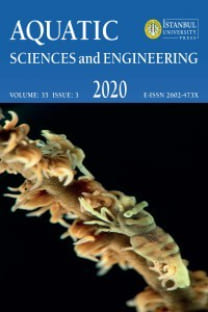Türkiye’nin Zehirli Balıklarından Trakonya Balığının Toksik Etkileri
Bu derleme çalışmasında ülkemiz kıyılarında dağılım gösteren trakonya balıklarının zehir ve toksik etki mekanizmaları ile tedavi yolları irdelenmiştir. Trakonya zehri, solungaç kapağı üzerinde bulunan operküler dikende ve 1.dorsal yüzgeçte bulunan 5-8 dorsal dikende bulunur. Trakonya zehirlenmeleri ani bir ağrı, yanma ve iğneleme şeklinde ortaya çıkmaktadır. Bu bulguların süresi hastaya, balığın cinsine ve mevsimlere göre değişmektedir. Halk arasında bilinenin aksine acil servis müdahalesi olarak soğuk su yerine etkilenen bölgenin 60-90 dakika yaklaşık 40oC veya daha sıcak suya daldırılması gerekmektedir.
Anahtar Kelimeler:
Zehirli balıklar, trakonya, ilk yardım
Toxic Effects of Weever Fishes among Poisonous Fishes along the Coast of Turkey
In this review, the mechanism of action of poisons and toxic effects of and treatment methods for the same among weever fishes, which are present along the coast of Turkey, were addressed. Weever fish poison is present in the spicule located on the operculum and in the 5th-8th dorsal spines located on the first dorsal fin. Weever fish poisoning is identified through symptoms of intense pain, burning, and stinging. The duration of these symptoms varies among patients and depends on the species and season. Contrary to common belief, instead of immersion in cold water, immersion in hot water at about ≥40°C is used during emergencies.
Keywords:
Poisonous fishes, weever fishes, first aid,
___
- Barton, D. (2001). The venom apparatus of the Weever Fish (Trachinus vipera). www.users.totalise.co.uk/darrenbarton (19.11.2013).
- Bonnet, M.S. (2000). The toxicology of Trachinus vipera: The lesser weeverfish. British Homeopathic Journal, 89, 84-88.
- Briars, G.L. and Gordon, G.S. (1992). Envenomation by the lesser weever fish. British Journal of General Practice, 42, 213.
- Cain, D. (1983). Weever fish sting: an unusual problem. British Medical Journal, 287, 406-407.
- Carlisle, D.B. (1962). On the venom of the lesser weeverfish, Trachinus vipera. Journal of the Marine Biological Association UK, 42, 155-162.
- Davies, R.S. and Evans, R.J. (1996). Weeverfish stings a report of two cases presenting to an accident and emergency department. Journal of Accident & Emergency Medicine, 13, 139-141.
- Dehaan, A., Ben-Meir, P., Sagi, A. (1991). A “scorpion fish” (Trachinus vipera) sting: fishermen’s hazard. British Journal of Industrial Medicine, 48: 718-720.
- Dinçer, Ü., Çakar, E., Zeki, K.M., Dursun, H. (2008). Çarpan Balığı (Trakonya) ile Yaralanmaya Bağlı Kompleks Bölgesel Ağrı Sendromu: Bir Olgu Nedeniyle. Fiziksel Tıp ve Rehabilitasyon Bilimleri Dergisi, 1, 27-29.
- Eliras, A., Botwin, S., Von-der-Walde, I., Naor, B. (1974). Poisonous fish stings. Harefuah, 86, 367.
- Eryılmaz, M., Durusu, M., Menteş, M.O., Yiğit, T., Zeybek, N., Öner, K. (2006). Envenomation Caused by Weever Fish. The Journal of Emergency Medicine, 6(3), 142-145.
- Evans, H.M. (1907). Observations on the poisoned spines of the weeverfish Trachinus draco. British Medical Journal, 1, 73-76.
- Evans, H.M. (1943). Stingfish and seafarer. London: Faber & Faber, Ltd.
- Fischer, W., Schneider, M., Bauchot, M.L. (1987). Fishes FAO d’identification des Especes pour Les Besoins de La Peche. Mediterrancee et Mer Noire. Zone de Peche 37. Vertebres Vol 2.
- Froese, R. and Pauly, D. (2017). FishBase. World Wide Web electronic publication. www.fishbase.org (20/11/2017).
- Gücü, A.C. and Güre, F. (1994). Akdeniz’in Türkiye sahilleri boyunca rastlanan zehirli deniz balıkları, zehirlenme aygıtları ve zehirlenme durumunda tedavi yöntemleri. Turkish Journal of Zoology, 18, 25-35.
- Greenwood, P.H. (1975). Weever fishes. Practitioner, 215, 223-225.
- Halstead, B.W. (1959). Dangerous Marine Animals. Cornell Maritime Press Cambridge, Maryland, 146p.
- Halstead, B.W. (1988). Poisonous and venomous marine animals of the world. Princeton: Darwin Press. ISBN: 978-0878500505
- Junghanss, T. and Bodio, M. (2006). Medically Important Venomous Animals: Biology, Prevention, First Aid, and Clinical Management. Travel Medicine, 43, 1309-1317.
- Kalkan, Ş. (2012). Deniz canlıları ısırma sokmaları. Türk Farmakoloji Derneği Klinik Toksikoloji Çalışma Grubu e-Bülten, 3, 2-17. Maretic, Z., and B. Vejnovic. (1990). Record weeverfish, Trachinus radiatus. Toxicon, 28, 125-126.
- McGoldrick, J. and Marx, J.A. (1990). Marine envenomations. Part 1. Vertebrates. The Journal of Emergency Medicine, 9, 497-502.
- Perriere, C., Goudey-Perriere, F., Petek, F. (1988). Purification of a lethal fraction from the venom of the weeverfish, Trachinus vipera. Toxicon, 26, 1222-1227.
- Russell, F.E. and Emery, J.A. (1960). Venom of the weever Trachinus draco and Trachinus vipera. Annals of the New York Academy of Sciences, 90, 805-819.
- Russell, F.E. (1983). Weever fish sting: the last word. British Medical Journal, 287, 981-982.
- Sutherland, S.K. and Tibballs, J. (2001). Australian animal toxins: the creatures, their toxins and care of the poisoned patient. 2nd ed. Melbourne: Oxford University Press.
- Tortonese, E. (1986). Trachinidae. In J.C. Hureau and Th. Monod (eds.) Check-list of the fishes of the north-eastern Atlantic and of the Mediterranean (CLOFNAM). UNESCO, Paris. Vol. 2. p.951-954.
- Yayın Aralığı: Yılda 4 Sayı
- Başlangıç: 1987
- Yayıncı: İstanbul Üniversitesi
Sayıdaki Diğer Makaleler
Nesrin EMRE, Kazım UYSAL, Yılmaz EMRE, Mustafa KAVASOGLU, Özgür AKTAŞ
Bekir TUFAN, Gülsüm BALÇIK MISIR, Sevim KÖSE
Türkiye’nin Zehirli Balıklarından Trakonya Balığının Toksik Etkileri
Taner Yıldız, F. Saadet Karakulak
Su Ürünleri İşleme Atıklarının Değerlendirilmesi
Hatice GÜNDÜZ, Fatma ÖZTÜRK, Sevim HAMZAÇEBİ, M. Dilcan AKPINAR
